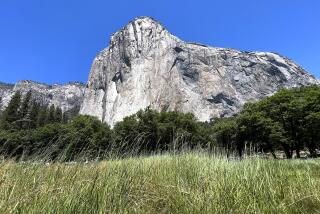Wilderness Status Urged for Most of Grand Canyon
- Share via
PHOENIX — The National Park Service says it’s time to start managing Grand Canyon National Park like the true wilderness it is.
The agency has proposed treating 94% of the 1.3-million-acre national park as wilderness--the highest level of protection granted any federal land--by year’s end.
The new management plan calls for a ban on new roads, buildings and motorized vehicles and would require that more than 120 miles of old roads be turned into trails or restored to their natural condition.
“It’s only been in recent times that the hierarchy of the Park Service has recognized the significance of wilderness management,” said Linda Jalbert, the park’s outdoor recreation planner.
“Even though it’s a national park, we get a lot of pressure for new uses.”
Among the proposals have been new helicopter landing pads, a gondola from the rim to the river, new hotel lodges and even floating casinos.
The management plan does not require congressional approval. However, an accompanying proposal to lock in the wilderness designation does.
The plan also could mean that park rangers would repair trails with less intrusive picks and shovels, as opposed to chain saws and jackhammers, to protect the serenity of the wilderness.
The plan also calls for stepped-up education programs for back-country hikers and scientific investigators. In the last decade, several hikers have died and thousands more have been evacuated because of heat exhaustion and dehydration.
Since 1980, when most of the park was first proposed as wilderness, the Park Service has bought grazing, mining and other private development rights, conducted land-use studies and increased the acreage proposed for wilderness by nearly 10%.
The new draft Wilderness Management Plan goes further, calling for 1,109,257 acres to be officially designated as wilderness as soon as Congress agrees. That would include nearly all of the canyon’s inner gorges, most of the North Rim, and the South Rim west of Hermit’s Rest.
“All the footwork has been done,” Jalbert said. “The next step would be to present a bill to Congress.”
How far such a bill would get in the current Congress is questionable. Last year Congress proposed the opposite--designating millions of miles of roadways in federal forests and parks to maintain access for developers. Under pressure from park advocates and a veto threat from President Clinton, the roads proposal was dropped.
The Park Service’s grand plan also calls for 29,820 acres--the Colorado River that flows for 277 miles through the park, and its shoreline--to be designated as proposed wilderness, and that studies be done to include the river in the nation’s “Wild and Scenic” river program.
The “wild and scenic” designation, which could be done by Congress or the secretary of the Interior, would forever prohibit dams or diversions, such as were proposed in the 1950s and 1960s.
Currently, 39 miles of the Verde River above Horseshoe Lake is the only Arizona waterway with such protections, although environmentalists have called for up to 1,700 miles of the state’s rivers and streams to be added.
The wilderness proposal covers virtually the entire park except for the two most used trails, Bright Angel and Kaibab.
It also excludes the few areas inside the park--mostly surrounding Grand Canyon Village and the South Rim east of the village--that already are developed or have paved roads. Those areas, which handle most of the park’s 5 million visitors each year, are subject to other park management plans.
Citizens have until July 15 to submit comments on the proposed management plan.
More to Read
Sign up for Essential California
The most important California stories and recommendations in your inbox every morning.
You may occasionally receive promotional content from the Los Angeles Times.













